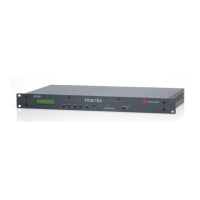Parametric 1
Low Shelf 2
High Shelf 3
Lowpass 4
Highpass 5
Linkwitz-Riley Lowpass 6
Linkwitz-Riley Highpass 7
This command has the same format and restrictions as the
PEQIA command except that only one
parameter, the filter type, is specified instead of all the parameters. See the
PEQIA command for more
information. To set the slope parameter for an output parametric EQ filter, use the
PEQOT command.
To set all the parameters for an output parametric EQ filter, use the
PEQOA command.
This command is saved to non-volatile memory only as part of a preset. The state of this command will
be restored after power-up only if a preset is saved and that preset is set to be the power-on preset.
Example Description Status Message
T01PEQITT,2,1
Set the type of the parametric EQ
on input T, band 2 to parametric.
T01PEQITT,2,1
T01PEQITT,1,?
Query current type setting of
parametric EQ on input T, band 1.
T01PEQITT,1,t, where t is the current
setting of the type parameter for the parametric
EQ on input T, band 1. If the type parameter of
this filter is set to the same value given in the
example above, then the status message will be
T01PEQITT,1,1.
8.85. PEQOA -- Set All Parameters for Specified Parametric
EQ Output Stage
This command sets or queries all of the parameters for the parametric equalizer (EQ) filters on . Each
channel has five bands of parametric EQ that can be independently controlled.
The output parametric EQ filter parameters can be set individually via the
PEQOT, PEQOF, PEQOB,
PEQOG, PEQOS, and PEQOE commands. The input parametric EQ filter parameters can be set
simultaneously via the
PEQIA command or individually with the PEQIT, PEQIF, PEQIB, PEQIG,
PEQIS, and PEQIE commands.
When using this command, you must specify all of the following parameters.
Description Value Range Units
Channel T N/A
Band 1-5 N/A

